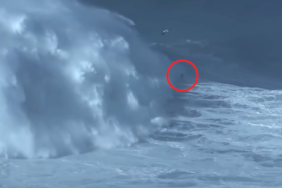Photo: Detail from the cover of Surfer magazine.
John Severson, artist, writer, filmmaker, and founder of Surfer magazine, died in his sleep on Friday, May 26, at his home outside Lahaina on the island of Maui at the age of 83. He had been fighting an accelerated battle against a rare form leukemia.
Also: Winning the Fight to Bring the Coral Reefs of the Florida Keys Back to Life
His wife Louise wrote, “John died here in Napili, in the house he loved, at the surf sport he loved. It was a beautiful sunny morning and four of his girls were around him.”

A pioneer of modern surf culture, Severson grew up riding the waves of Southern California on a redwood board. He was drafted into the Army in 1956 and bound for Germany until an unexpected change in assignments brought him to the Army base in Oahu, the birthplace of surfing. Here, he did illustrative work creating maps. He joined the Army surf team and began to photograph and film the burgeoning scene on the shores of Hawaii. He stayed on base until he was discharged in 1958, then returned to California.
The Hollywood commodification of the sport, as seen in films like “Gidget” (1959) and the 1960s beach party movies with Frankie Avalon and Annette Funicello were the antithesis of everything that he loved. He described the theatrics as a “cheap, honky look at surfing.”

In his 2014 book, John Severson’s SURF (Damiani/PUKA PUKA), the author explained that a new breed of poseurs had arrived, wanting to be down with the culture. He wrote, “Their role models were Hollywood stereotypes, and the sport quickly picked up a bad name. Wannabes came into the sport as rebels, pranksters, vandals, and thieves, wearing Nazi imagery — helmets and iron crosses. Surfers hated those Hollywood surf films, and I could see that Surfer could create a truer image of the sport.”
In 1962, he launched Surfer, the first major magazine devoted to the sport. Before Severson arrived on the scene, there was no surf media, industry, or culture of which to speak. It was his work that introduced surfing to the American public.
As an independent publisher, Severson did it all, from writing and editing to photographing, designing, and art direction. The magazine went from an annual to a quarterly, and finally went monthly on a shoestring budget. All that mattered for Severson was staying true.
By the early 1970s, Surfer had 100,000 readers and solid advertisers, putting Severson at the top of his game. He bought a home in the gated community of Orange County, which he enjoyed to the fullest extent until the next door neighbors moved in: President Richard Nixon.
Surfing stood as the antithesis to all that Nixon’s administration represented. Severson realized a shift had come, and he sold the magazine for an undisclosed sum that enabled him to return to Hawaii to create art, ride the waves, and enjoy life as a family man.
As a filmmaker, Severson made “Surf,” Surf Safari,” Surf Fever,” and, most famously, “Pacific Vibrations,” a Warner Bros. release. One of Severson’s priorities later in life was to protect the oceans and restore the coral reefs.
Miss Rosen is a journalist covering art, photography, culture, and books. Her byline has appeared in L’Uomo Vogue, Vogue Online, The Undefeated, Dazed Digital, Aperture Online, and Feature Shoot. Follow her on Twitter @Miss_Rosen.
John Severson
-
In Memory of John Severson (1933-2017), Founder of Surfer Magazine

Surfer magazine.
-
In Memory of John Severson (1933-2017), Founder of Surfer Magazine

Surfer magazine.
-
In Memory of John Severson (1933-2017), Founder of Surfer Magazine

Pacific Vibrations movie poster.
-
In Memory of John Severson (1933-2017), Founder of Surfer Magazine

Surfer magazine.
-
In Memory of John Severson (1933-2017), Founder of Surfer Magazine

Surfer magazine.
-
In Memory of John Severson (1933-2017), Founder of Surfer Magazine

Surfer magazine.
-
In Memory of John Severson (1933-2017), Founder of Surfer Magazine

Surfer magazine.
-
In Memory of John Severson (1933-2017), Founder of Surfer Magazine

Surfer magazine.
-
In Memory of John Severson (1933-2017), Founder of Surfer Magazine

Surf Fever movie.
-
In Memory of John Severson, Founder of Surfer Magazine

Surfer magazine.
-
In Memory of John Severson (1933-2017), Founder of Surfer Magazine

Surfer magazine.
-
In Memory of John Severson (1933-2017), Founder of Surfer Magazine

Surfer magazine.
-
In Memory of John Severson (1933-2017), Founder of Surfer Magazine

Surfer magazine.






